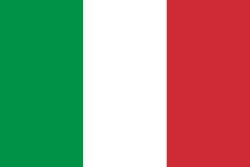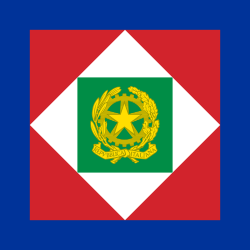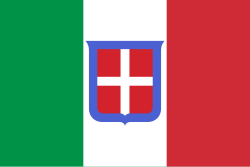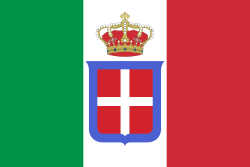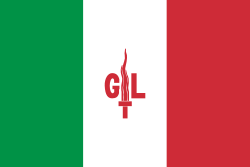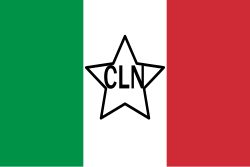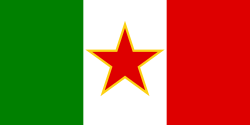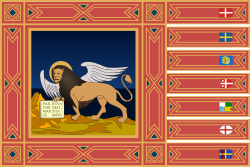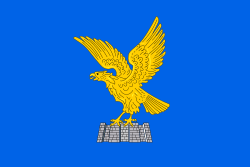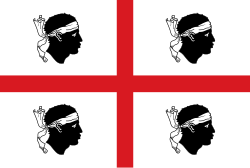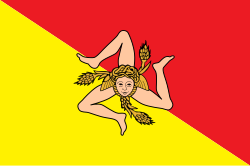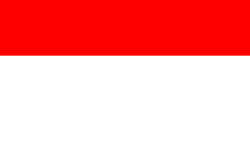| Flag | Date | Use | Description |
|---|
 | 800–888 | Imperial Orilflamme of Charlemagne | A 3 pointed green field with 8 golden crosses and 6 flowers. |
 | 800–1420 | Flag of The Judicate of Arborea | A White Field with a Tree in the center. |
 | 831–1091 | Flag of the Emirate of Sicily | A Simple Green Field. |
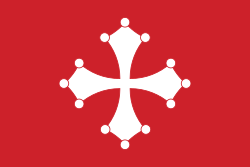 | 1000–1406 | Flag of The Republic of Pisa | A Red Field with a White Cross in the center. |
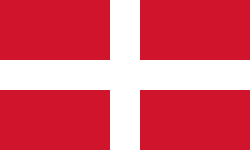 | 1115–1251 | 1st Flag of The Republic of Florence | A red field with centred white cross. |
 | 1130–1194 | Banner of The Hauteville Dynasty | A Blue Field with a white and red checkered diagonal stripe. |
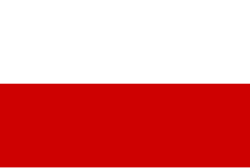 | 1160–1200 | 1st Flag of The Republic of Lucca | A Horizontal Bicolor of White and Red, similar to the Polish flag. |
 | 1171–1277 | 1st Flag of Milan | A White Field with a Red Maltese cross in the center with 3 sestiere on the fly. |
 | 13th century | 1st Flag of The Republic of Siena | A black field with a white stripe and 3 sestiere on the fly. |
 | 1200–1799 | 2nd Flag of The Republic of Lucca | A Blue Field with a Golden diagonal stripe with the word Libertas. |
 | 1176–1395 | Flag of The Commune of Milan | A white field with centred red cross, the same of The Flag of England, both coming from Genoa. |
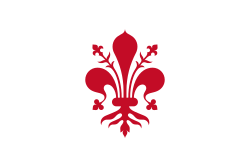 | 1251–1569 | 2nd Flag of The Republic of Florence | A White Field with a Red Fleur-de-lis lily in the center. |
 | 1258–1266 | Banner of Manfred, King of Sicily | A White Swallowtail Flag with a Black Eagle in the center. |
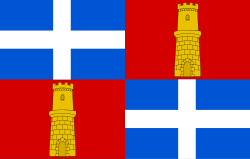 | 1259–1323 | Flag of The Republic of Sassari | 4 quartered field. a white cross in the 1st and 4th quarter (blue) and a white tower in the 2nd and 3rd quarter (red). |
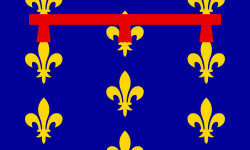 | 1266–1442 | Flag of The Kingdoms of Sicily and Naples under The Capetian House of Anjou | A Blue Field with Several Fleur-de-lis and a red label. |
 | Flag of The Kingdoms of Sicily and Naples under The Capetian House of Anjou (Variant) |
 |
 | 1277–1395 | 2nd Flag of Milan | A white field with a blue snake devouring a man in the center. |
 | 1282–1296 | 1st Flag of The Kingdom of Sicily under The Crown of Aragon | The Aragonese Senyera in the first and fourth quarters and the Eagle of Sicily in the second and third quarters. |
 | 1290–1555 | 2nd Flag of The Republic of Siena | A Horizontal Bicolour of white and black. |
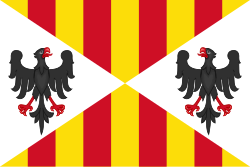 | 1296–1410 | 2nd Flag of The Kingdom of Sicily under The Crown of Aragon | Similar to the Aragonese Senyera, but with 2 white triangles with an eagle inside of both triangles. |
 | 14th century | Gorizia | A square flag with a blue background on the right and the Lion of Gorizia. The lion was the original coat of arms of the County of Gorizia, while the bar on the left was taken from the flag of vassalage to the Patriarchate of Aquileia, which existed in 1338. |
 | 1339–1797 | Flag of The Republic of Genoa | A white field with centred red cross, similar to The Flag of England, but with five sestiere on the fly. |
 | 1395–1499 | State Flag (Vexillum publicum) of the City of Milan | A white field with centred red cross, similar to The Flag of England. |
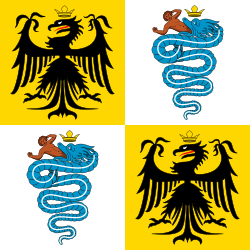 | 1395–1499 | 3rd Flag of Milan | The Imperial Eagle of the Holy Roman Empire in the first and fourth quarters and the Snake of Milan in the second and third quarters. |
 | 1398–1701 | 1st Flag of The Principality of Piombino | A white field with a chess themed diagonal red stripe. |
 | 1410–1516 | 3rd Flag of The Kingdom of Sicily under The Crown of Aragon | An inverted version of the previous flag. |
 | 1416–1785 | Flag of The Duchy of Savoy | A red field with centred white cross. |
 | 1442–1516 | Flag of The Kingdom of Naples under The Crown of Aragon | The Aragonese Senyera in the first and fourth quarters and the stripes of The Árpád dynasty, The Fleur-de-lis of Anjou and The Cross of Jerusalem in the second and third quarters. |
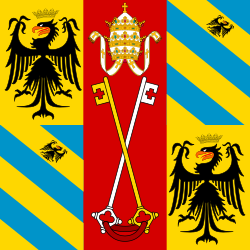 | 1443–1523 | 1st Flag of The Duchy of Urbino | A Banner of Arms with the symbols of the Holy Roman Empire, The House of Montefeltro and The Papal States. |
 | 1447-1450 | State flag ( Vexillum publicum ) of the Golden Ambrosian Republic | A white field with centred red cross, with the republic's seal. |
 | 1452–1830 | 1st Flag of The Duchy of Modena and Reggio | A crowned white eagle on a blue field. |
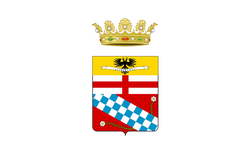 | 1473–1829 | Flag of The Duchy of Massa and Carrara | A White field with the coat of arms in the center. |
 | 1499–1526 | 4th Flag of Milan (Under French rule) | the French royal flag in the first and fourth quarters and the Snake of Milan in the second and third quarters. |
 | 1523–1625 | 2nd Flag of The Duchy of Urbino | A yellow swallow-tailed field with a disc which contains the symbol of The House of Montefeltro. |
 | 1545–1731 | 1st Flag of The Duchy of Parma and Piacenza | A Yellow field with 6 blue Fleur-de-lis in the center. |
 | 1562–1737 | 1st Flag of The Grand Duchy of Tuscany | A White Field with The Coat of Arms of The Medici Family in the center. |
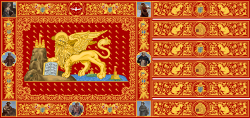 | 1659–1675 | The Contarina flag of the Republic of Venice | A gold Lion of St. Mark on a field of dark red accompanied by six sestiere on the fly. |
 | 1701–1803 | 2nd Flag of The Principality of Piombino | A white field with the coat of arms in the center. |
 | 1765–1800 | 2nd Flag of The Grand Duchy of Tuscany | A Horizontal Tricolour of red, white and red with The Greater Coat of Arms in the center. |
| 1815–1848 |
| 1849–1860 |
 | 1785–1802 | 1st Flag of The Kingdom of Sardinia | Blue with the cross of savoy occupying one quarter of the field and placed in the canton. |
 | 1799–1801 | 3rd Flag of The Republic of Lucca | A Horizontal Tricolour of green, white and red. |
 | 1801–1805 | 4th and Final Flag of The Republic of Lucca | A White field with a centered red diamond and with a blue border. |
 | 1801–1807 | Flag of The Kingdom of Etruria | 5 Stripes alternating of Blue and White with the coat of arms in the center. |
 | 1802–1814 | 2nd Flag of The Kingdom of Sardinia | Blue with the St George's Cross and four heads of Moors occupying one quarter of the field and placed in the canton. |
 | 1814–1816 | 3rd Flag of The Kingdom of Sardinia | Blue with the cross of savoy and 2 St George's Crosses in the 1st and 4th quarters (one of them with four heads of Moors) occupying one quarter of the field and placed in the canton. |
 | 1815–1818 | 1st Flag of The Duchy of Lucca | A Horizontal Bicolour of yellow and red. |
 | 1815–1847 | 2nd Flag of The Duchy of Parma and Piacenza | A Vertical Bicolour of red and white. |
 | 1815–1848 | 2nd Flag of The Grand Duchy of Tuscany (Lesser Arms Variant) | A Horizontal Tricolour of red, white and red with The Lesser Coat of Arms in the center. |
| 1849–1860 |
 | 1816–1848 | 4th Flag of The Kingdom of Sardinia | Blue with a combination of the crosses of savoy and St George occupying one quarter of the field and placed in the canton. |
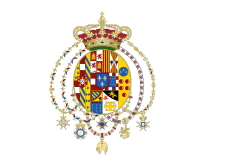 | 1816–1848 | Flag of The Kingdom of the Two Sicilies | A White Field with The Arms of The King of the Two Sicilies in the center. |
| 1849–1860 |
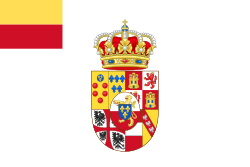 | 1818–1824 | 2nd Flag of The Duchy of Lucca | A White Field with the coat of arms in the center and a bicolour of yellow and red in the canton. |
 | 1824–1847 | 3rd and Final Flag of The Duchy of Lucca |
 | 1830–1859 | 2nd Flag of The Duchy of Modena and Reggio | A horizontal tricolour of red, white and red with a centred vertical tricolour of blue, white and blue with the coat of arms in the center. |
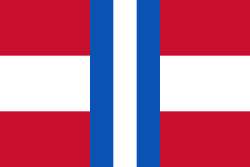 | 2nd Flag of The Duchy of Modena and Reggio (Civil variant) | A horizontal tricolour of red, white and red with a centred vertical tricolour of blue, white and blue. |
 | 1848–1849 | 3rd Flag of The Duchy of Parma and Piacenza | A Horizontal Bicolour of yellow and blue. |
 | 1849 | Revolutionary flag of Brescia | A Square Tricolour of green, white and red. |
 | 1850–1851 | 4th Flag of The Duchy of Parma and Piacenza | 12 Spinning Stripes alternating of blue and yellow. |
 | 1851–1859 | 5th and Final Flag of The Duchy of Parma and Piacenza | 8 Spinning Stripes alternating of blue and yellow with a red border. |


